|
|
 40 phenology of wing color DHJanzen100633.jpg high resolution
|
|
|
Here you can see this process in action. Here, displayed with their dates of eclosion are all the brothers to emerge from two clutches of siblings reared in the late rainy season of one year, and eclosing at the beginning of the rainy season in the following year (after having been dormant for a six month dry season). They are arranged above the date cards, with one clutch of sibs immediately above the cards, and the other clutch of sibs above them, with a space in between. The card with the arrow indicates the beginning of the rains this year. Even though all these are sibs and in the same cage - therefore subject to the same cues - they responded to the rains by eclosing over a period of 35 days. In both clutches, the major color shift in eclosing males occurred 3-4 days after the cooling of the first rains (and this is yet more evident in the closer image of the same moths in DHJanzen100634.jpg below). This suggests that the temperature 3-4 days before eclosion sets the wing color. It is striking that the general darkening of the habitat following the first rains becomes noticeable to the human observer about 3-4 days after the first rains as well. |
||
back to lecture slides
or skip to: